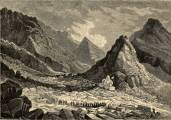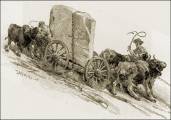


SOAPSTONE.
By Edward W. Parker.
Soapstone or talc is found in nearly every State along the Atlantic Slope, the principal deposits being in New York and North Carolina, though it is also quarried in New Hampshire, Vermont, Massachusetts, New York, New Jersey, Pennsylvania, Maryland, Virginia, North Carolina, and Georgia. It has also been reported in some of the Western States, particularly in California, Arizona, South Dakota, and Texas, but no commercial product has been obtained west of the Mississippi River. Pure soapstone is a massive amorphous mineral, usually white, light green, or gray in color. In some cases, notably at Gouverneur, St. Lawrence County, N. Y., it occurs in a foliated or fibrous form, very valuable as a filler or makeweight in the manufacture of paper. This latter variety, known as fibrous talc or mineral pulp, is considered separately these reports.
The aboriginal inhabitants of North America recognized soapstone as a valuable mineral. Its resistance to heat and the ease with which it could be worked into desirable shapes, even with the crude implements at their command, made the manufacture of cooking utensils from soapstone one of their few industrial occupations. Tobacco pipes and articles used in their religious ceremonies were also made of soapstone, and traces of their handiwork are still found in the vicinity of soapstone deposits. The uses to which soapstone is applied to-day are very numerous, though in the light of present knowledge the development of the industry seems to have been exceedingly slow. It makes a more durable and satisfactory lining for cooking stoves, heaters, and furnaces than ordinary fire brick. Soapstone does not absorb grease or acids, and is not affected by the ordinary chemical agents, and is as impervious to extreme cold as to heat, making it especially valuable for sinks, etc., in chemical laboratories. Laundry tubs, hearths, mantels, and stove griddles are produced from soapstone, and the readiness with which all dirt and impurities are removed make it popular with housekeepers. The manufacture of slate pencils from soapstone is an industry as old as the manufacture of slates. Ground soapstone is used chiefly as a makeweight in paper manufacture, but it is also used as a base for pigments and cosmetics, as an adulterant in soap and rubber, for dressing skins and leather, and for lubricating.
The amount of soapstone produced in the United States in 1894 was 23,144 short tons, valued at $401,325, against 21,071 short tons, worth $255,067, in 1893. The increase in production was in the amounts sawed into slabs, and ground. The production of manufactured articles decreased slightly, but the value of the products shows a gain of over $110,000, or over 40 per cent.
Following is a statement of the production of soapstone (exclusive of fibrous talc and soapstone ground for paint) in 1893 and 1894, showing the amount and value of the different conditions in which it was marketed:
|
Production of soapstone in 1893 and 1894. |
||||
|
Condition in which marketed |
1893 |
1894 |
||
|
Rough |
5.760 |
$51,600 |
5,620 |
$50,780 |
|
Sawed into slabs |
104 |
4,400 |
1,303 |
19,50 |
|
Manufactured articles (a) |
7,070 |
123,600 |
6,425 |
244,000 |
|
Ground (b) |
8,137 |
75,467 |
9,796 |
87,045 |
|
Total |
21,071 |
$255,067 |
23,144 |
$401,325 |
a Includes bath and laundry tubs; fire brick for stoves, heaters, etc.; hearthstones, mantles, sinks, griddles, slate pencils, and numerous other articles of everyday use.
b For foundry facings, paper making, lubricators, dressing skins and leather, etc.
c Exclusive of the amount used for pigment, which is included among mineral paints.
In the following table is shown the amount and value of soapstone produced in the United States since 1880:
|
Annual product of soapstone since 1880. |
|||||
|
Years |
Quantity |
Value |
Years |
Quantity |
Value |
|
|
Short tons |
|
|
Short tons |
|
|
1880 |
8,441 |
$66,665 |
1888 |
15,000 |
$250,000 |
|
1881 |
7,000 |
75,000 |
1889 |
12,715 |
231,708 |
|
1882 |
6,000 |
90,000 |
1890 |
13,670 |
252,309 |
|
1883 |
8,000 |
150,000 |
1891 |
16,514 |
243,981 |
|
1884 |
10,000 |
200,000 |
1892 |
23,208 |
423,440 |
|
1885 |
10,000 |
200,000 |
1893 |
21,070 |
255,067 |
|
1886 |
12,000 |
225,000 |
1894 |
23,144 |
401,325 |
|
1887 |
12,000 |
225,000 |
|
|
|
The supply of this variety of soapstone is obtained only at Gouverneur, St. Lawrence County, N. Y. The entire output is ground and used almost exclusively as a filler in the manufacture of the medium grades of paper. The product in 1894 was 39,906 short tons, valued at $435,060, an increase as compared with 1893, of 4,045 short tons in quantity and $31,624 in value. The largest output was in 1891, when the produce was 53,054 short tons, valued at $493,068. The annual production since 1880 has been as follows:
|
Annual product of fibrous talc since 1880. |
|||||
|
Years |
Quantity |
Value |
Years |
Quantity |
Value |
|
|
Short tons |
|
|
Short tons |
|
|
1880 |
4,210 |
$54,730 |
1888 |
a 20,000 |
$210,000 |
|
1881 |
a 7,000 |
60,000 |
1889 |
23,746 |
244,170 |
|
1882 |
a 6,000 |
75,000 |
1890 |
53,054 |
493,068 |
|
1883 |
a 6,000 |
75,000 |
1891 |
53,054 |
493,068 |
|
1884 |
a 10,000 |
110,000 |
1892 |
41,925 |
472,485 |
|
1885 |
a 10,000 |
110,000 |
1893 |
35,801 |
403,436 |
|
1886 |
a 12,000 |
125,000 |
1894 |
39,906 |
435,060 |
|
1887 |
a 15,000 |
225,000 |
|
|
|
a Estimated.
|
Talc imported into the United States from 1880 to 1894, inclusive. |
|||||
|
Years |
Quantity |
Value |
Years |
Quantity |
Value |
|
|
Short tons |
|
|
Short tons |
|
|
1880 |
----- |
$22,807 |
1888 |
24,165 |
$22,446 |
|
1881 |
----- |
7,331 |
1889 |
19,229 |
30,993 |
|
1882 |
----- |
25,641 |
1890 |
1,044 |
1,560 |
|
1883 |
----- |
14,607 |
1891 |
81 |
1,212 |
|
1884 |
----- |
41,165 |
1892 |
531 |
5,546 |
|
1885 |
----- |
24,356 |
1893 |
1,360 |
12,825 |
|
1886 |
----- |
24,514 |
1884 |
622 |
6,815 |
|
1887 |
(a) |
49,250 |
|
|
|
a Quantity not reported previous to 1888..
Commercial use of material within this site is strictly prohibited. It is not to be captured, reworked, and placed inside another web site ©. All rights reserved. Peggy B. and George (Pat) Perazzo.